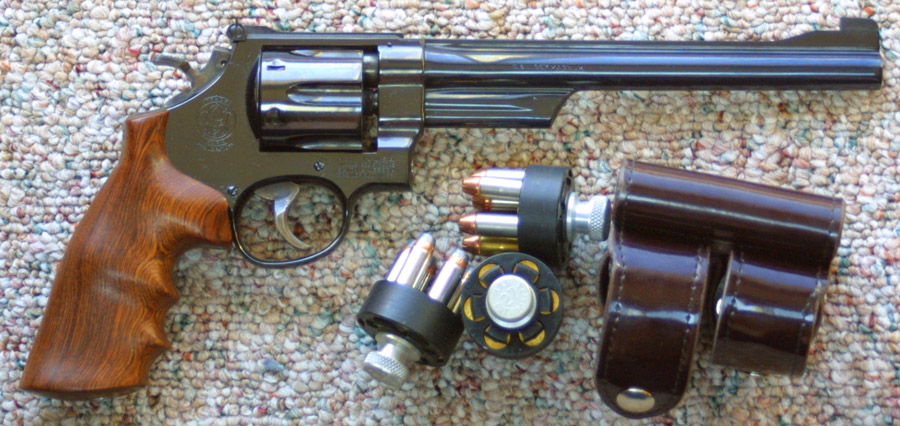
S&W M-27
| Length Overall | Barrel Length | Weight | Caliber | Action Type | Magazine Capacity |
| 13.5" | 8 3/8" | 49.5 oz | .357 Mag | D.A. Revolver | 6 |
This is more or less part of the production of the original 357 magnum pistol, though there is some blurring of models. This model was built upon the N frame which was the largest revolver frame made by Smith and Wesson, at the time. This was the frame upon which the 44 Magnum model 29 would eventually be based. Many people consider this to be the finest 357 magnum ever made, even surpassing the highly regarded Colt Python. This is a sentiment with which I am in enthusiastic agreement, though I do have some reservations, when considering my Dan Wesson revolvers. Even the Dan Wesson can not compare to the strength inherent in the large frame and huge cylinder of the Model 27. The Python is much more highly tuned and tweaked; but the M-27 has far more potential, and is much stronger. What earns this revolver such high esteem is the size, and weight of the frame upon which it is built. This is the largest, heaviest 357 revolver ever made by any company, due to it's being based upon a 44 sized frame. The cylinder walls of the
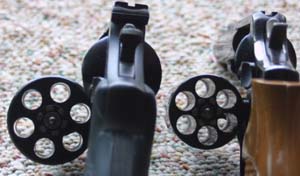 original version, are the thickest and strongest of any
357 revolver ever made, and the whole mechanism of the gun is, by 357
standards, overbuilt. This makes these guns particularly attractive
to handloaders, who prefer this pistols extra safety margin. The difference
in cylinders can be seen in the photo at right, comparing 357 N frame,
and standard K frame cylinders. The cylinder of the Model 27 is 1.75"
in width, compared to 1.45" for the standard K frame models.
original version, are the thickest and strongest of any
357 revolver ever made, and the whole mechanism of the gun is, by 357
standards, overbuilt. This makes these guns particularly attractive
to handloaders, who prefer this pistols extra safety margin. The difference
in cylinders can be seen in the photo at right, comparing 357 N frame,
and standard K frame cylinders. The cylinder of the Model 27 is 1.75"
in width, compared to 1.45" for the standard K frame models.This particular example features a blue finish, and sports the longest commonly available barrel, 8 3/8", that Smith makes. It also has a wonderful oil finished reverse wedge grip with finger cut outs. It has a target hammer, target trigger, target sights (TH, TT, TS, or the three t's, as S&W revolver enthusiasts like to refer to them), and a ramp front sight. I bought this gun to round out my 357 collection, and to have all of the common barrel lengths. As such, I partner it with my pair of S&W M-28 revolvers. All three of these guns are N frame, 357 revolvers. These closely related models differ mainly in their finish, and in some of the features. The M-27 has either a superior bright blue finish, or is nickel plated; the M-28 has a dull matte blue finish. The top strap of the Models 27 is magnificently grooved, as can be seen in the photo below, while that of the model 28 is smooth and sandblasted. A variety of target sights, hammers and triggers are available for the M-27, while the M-28 is offered with adjustable combat sights, along with standard triggers and hammers (though some have been equipped with target triggers and hammers).
These started out as semi custom firearms, allowing the purchaser to have the gun built in pretty much any configuration, to suit personal preferences. In it's early days, this gun was a special order model, and came with a certificate, including the owner's name, and a unique registration number. Nearly everyone requested the target hammer, target trigger, high profile rear sights, ramp front sight (out of a choice of seven different front sight styles) target grips with a special grip insert (to soak up that reputedly brutal recoil), as well as fancy checkering on the top strap and back strap. Latter on, special oversized target grips were offered. Smith and Wesson foresaw no problem in turning out these custom guns, since they imagined that few people would want them, particularly at the astronomical price, for the depression era world in 1935, of $60. A surprising total of about 5,500 of these .357 Magnum revolvers were registered during the four years before the company stopped the practice in 1939. This averages out to around 116 guns per month, or nearly 30 per week; far higher than the number that S&W had predicted, or was prepared to produce. When production was interrupted, due to the start of W.W.II, 6,642 .357 Magnum revolvers had been made.
In December 1948, production of the .357 Magnum was resumed, but the lockwork had been modernized and the barrel lengths were standardized at 3 1/2, 5, 6,
These guns were generally considered to be for target use, or for what in the early days was considered to be the exotic sport of hunting with a handgun. Ironically, the magnum cartridge was developed to address concerns of law enforcement officers, who had frequently found themselves outgunned by the new vicious breed of violent criminal; but it rarely made it's way into the ranks of the working lawman. The new flagship handgun was far too fancy and expensive for duty use, and most departments continued on with the .38 Special. Even the decision to name the cartridge a magnum, after the largest readily available size of champagne available, seemed to mark it as an exotic luxury item, rather than as a working tool. Few working policemen would have the means to afford either type of magnum, on their salaries. This eventually induced S&W to introduce the Highway Patrolman model, as a sort of a duty grade M-27, in 1954.
A new kind of cartridge
Though these facts are recounted
in several other places on this sight, a brief early history of the
series, and of the .357 Magnum cartridge seem to be called for here.
Experiments with supercharged 38 special cartridges, began in the twenties,
or perhaps even a bit earlier. The basis of these experiments was the
difference between the then new smokeless powders, and the black powder
that they had replaced. By comparison, the new smokeless powders were
considerably more powerful. Though black powder was no longer in common
use, the cartridge cases of most revolver rounds had been designed during
black powder days, and were oversized for the amount of smokeless powder
needed to drive a bullet, at the velocities considered standard for those
rounds. As an example, a 158 grain bullet might need 21 grains of black
powder to bring it up to a velocity of 800fps. The same bullet might attain
the same velocity with only 3 grains of certain smokeless powders. So,
what do you do about all of that empty space? The answer, for a few brave
handloaders, was to fill it. Increasing the load of powder in a case is a good way to blow out a cylinder, and possibly injure yourself, as many intrepid handloaders discovered (and continue to discover), to their sorrow. Smith and Wesson had recognized that there was quite a bit of untapped potential in the new powders, when it upgraded it's medium bore cartridge from the 38 S&W to the somewhat faster and more energetic 38 Special. Though the 38 Special is thought of as a rather feeble cartridge today, it was considered quite a hot round upon it's introduction, and was a great improvement over existing rounds; but there was still quite a bit of empty space in the cartridge case. Even so, S&W lengthened the 38 Special case a bit, over that of the old 38 S&W, not because the extra room was needed, but to prevent 38 Special cartridges from being fired in the old black powder 38 S&W revolvers. The metallurgy was improving; but there were still lots of old guns out in the world, even as there still are today.
Experimenters continued to attempt to wring more energy out of the new 38 special, but it was found that the 38 revolvers of the
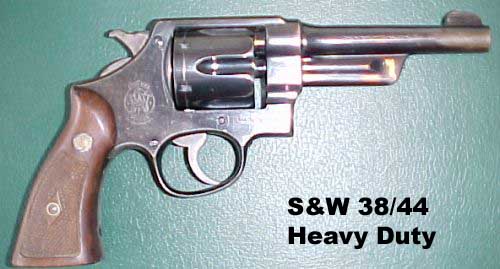 time could not withstand the pressures of loads that went
much above 800fps. This was the case until the introduction of the
model 38/44 in 1929. A photo of this model, found on the web, is displayed
to the left. The new revolver was a fixed sight 38 Special, with a
5" barrel, based on the S&W N frame. This was also known as the
44 frame, and was proportioned to the 44 and 45 caliber cartridges in
use by the military. The new gun took it's model designation from the
fact that it was a 38 revolver built upon a 44 frame. These were listed
in the catalog as the model 38/44 Heavy Duty. A year latter, an adjustable
sight version, with a 6" barrel was introduced as the Sportsman. These
guns were designed for a special loading of the 38 Special cartridge
called the 38HV, and had cylinders which were specially heat treated.
This new loading would drive a 158 grain bullet at 1175fps out of the
basic revolver's 5" barrel, as compared to the 800fps or so of the standard
loading. Still, the experimenters continued to hot load these guns. In
particular Elmer Keith and Phil Sharpe created loads which were pretty
close to what we would call 357 loads today, attaining velocities of 1450fps
with 158 grain bullets.
time could not withstand the pressures of loads that went
much above 800fps. This was the case until the introduction of the
model 38/44 in 1929. A photo of this model, found on the web, is displayed
to the left. The new revolver was a fixed sight 38 Special, with a
5" barrel, based on the S&W N frame. This was also known as the
44 frame, and was proportioned to the 44 and 45 caliber cartridges in
use by the military. The new gun took it's model designation from the
fact that it was a 38 revolver built upon a 44 frame. These were listed
in the catalog as the model 38/44 Heavy Duty. A year latter, an adjustable
sight version, with a 6" barrel was introduced as the Sportsman. These
guns were designed for a special loading of the 38 Special cartridge
called the 38HV, and had cylinders which were specially heat treated.
This new loading would drive a 158 grain bullet at 1175fps out of the
basic revolver's 5" barrel, as compared to the 800fps or so of the standard
loading. Still, the experimenters continued to hot load these guns. In
particular Elmer Keith and Phil Sharpe created loads which were pretty
close to what we would call 357 loads today, attaining velocities of 1450fps
with 158 grain bullets. Taking the lead from these experimenters, and responding to concerns expressed by law enforcement officers, S&W worked up a version of the Sportsman with a slightly lengthened cylinder, also specially heat treated, to fire a new loading of the 38
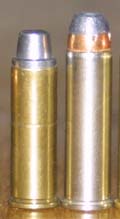 Special, loaded into a slightly lengthened cartridge case.
These new guns, and the new cartridge they fired, were both referred
to as the 357 Magnum. The new round launched a 158 grain bullet at
1500fps. The cartridge cases were lengthened for the same reason that
the 38 Special cartridge cases had been lengthened over the old 38 S&W:
to keep the new loads from being used in older guns not up to their power
levels. These guns were introduced in 1935, and were the most powerful
handguns in the world at that time, and for many years afterward. A photo
of the two cartridges is shown to the right. One of the real advantages
of the way the round was developed, was that it would allow for the use
of standard 38 Special cartridges. This was an important advantage, back
when the 357 was an exotic, expensive and sometimes difficult to find
cartridge. Even today, it is an advantage for the gun enthusiast who does
not always wish to subject gun or shooter to the constant pounding of the
powerful magnum loads. So important is this compatibility factor, that
the absence of anything like a popular 41 special round may be, in large
measure, the reason for the slow acceptance, and general indifference of
the shooting public to the excellent 41 Magnum.
Special, loaded into a slightly lengthened cartridge case.
These new guns, and the new cartridge they fired, were both referred
to as the 357 Magnum. The new round launched a 158 grain bullet at
1500fps. The cartridge cases were lengthened for the same reason that
the 38 Special cartridge cases had been lengthened over the old 38 S&W:
to keep the new loads from being used in older guns not up to their power
levels. These guns were introduced in 1935, and were the most powerful
handguns in the world at that time, and for many years afterward. A photo
of the two cartridges is shown to the right. One of the real advantages
of the way the round was developed, was that it would allow for the use
of standard 38 Special cartridges. This was an important advantage, back
when the 357 was an exotic, expensive and sometimes difficult to find
cartridge. Even today, it is an advantage for the gun enthusiast who does
not always wish to subject gun or shooter to the constant pounding of the
powerful magnum loads. So important is this compatibility factor, that
the absence of anything like a popular 41 special round may be, in large
measure, the reason for the slow acceptance, and general indifference of
the shooting public to the excellent 41 Magnum.These original 357 revolvers were premium, high priced guns. J Edgar Hoover was given one of the first, and General George Patton purchased one, as a mate to his trusty 45. Most mere mortals had to wait months, or even years to get their hands on one. Each gun was virtually custom made. The user had a choice of barrel lengths, sight type, trigger and hammer style, finish, and even the load and range to which the sights might be calibrated. Each gun came with a certificate with the owners name, and a presentation case. Taking delivery of your new S&W 357 Magnum was an event. It was, unfortunately for S&W, not quite so rare an event as they had at first imagined. Even during depression times, the demand for these custom, expensive revolvers was becoming burdensome. Though Smith was a large company, it was set up for volume production, not for the demands of custom work. Frames and cylinders could be production pieces; but everything else needed to be hand made, in unpredictable numbers, often in non standard lengths or designs, according to the specific requests of individual purchasers. Each gun then needed to be registered, and have it's certificate filled out. This was time consuming, and labor intensive. It was also an interruption of procedure, and a bit of a drag on the assembly line.
In 1957, the 357 magnum model, had it's name changed to the Model 27, while the outdoorsman became the Model 22, and the 38/44 Heavy Duty, became the model 20. Both of the N frame 38 caliber revolvers would be discontinued in 1966. The M-27 would soldier on unchanged, until 1982, when S&W discontinued the practice of counterboring cylinders, and pinning barrels. As a considerably less fancy gun, the big Smith would be offered in all three barrel lengths until 1992, when only the 6" would be available. Finally the ax fell in 1994, after just under sixty years of production. Even before being
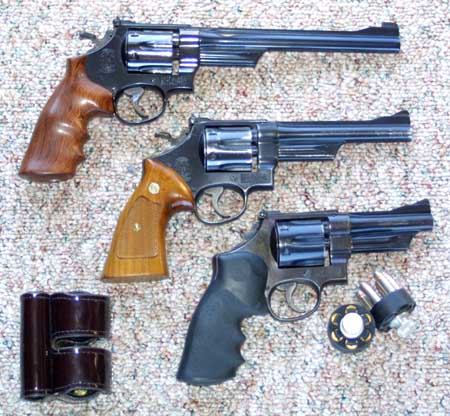 discontinued, the M-27 was passing away. While the other
two members of the S&W N frame magnum triad were faithfully rendered
in stainless steel, as the models 629 (44 Magnum), and 657 (41 Magnum),
this was not to be the case with the Model 27. A standard stainless
version of the model 27 was never produced. Instead, the 627 was to
become a sort of a mutation, a caricature of the classic Model 27.
In the last model variants, S&W introduced 8 shot cylinders, which
compromised the strength of the guns, giving them little or no strength
advantage over their medium frame counterparts.. They then began to
introduce one custom version after another, featuring counterweights,
cut out barrels, streamlined full length barrel lugs, and a number of
other oddities. The old M-27 had become unrecognizable, a shadow of it's
old self, and a bizarre series of design exercises by the marketing department.
It was almost a relief when the series was put out of it's misery.
discontinued, the M-27 was passing away. While the other
two members of the S&W N frame magnum triad were faithfully rendered
in stainless steel, as the models 629 (44 Magnum), and 657 (41 Magnum),
this was not to be the case with the Model 27. A standard stainless
version of the model 27 was never produced. Instead, the 627 was to
become a sort of a mutation, a caricature of the classic Model 27.
In the last model variants, S&W introduced 8 shot cylinders, which
compromised the strength of the guns, giving them little or no strength
advantage over their medium frame counterparts.. They then began to
introduce one custom version after another, featuring counterweights,
cut out barrels, streamlined full length barrel lugs, and a number of
other oddities. The old M-27 had become unrecognizable, a shadow of it's
old self, and a bizarre series of design exercises by the marketing department.
It was almost a relief when the series was put out of it's misery.
Shown in the photo to the left, is a set of the most commonly available barrel lengths of the N frame 357 Magnum revolvers. The uppermost is the 8 3/8 inch barreled M-27. Below it are the slightly less fancy M28 Highway patrolman models with 6 inch and 4 inch barrels. Barrels as short as 3 1/2 inch, and as long as 10 inch have been made available as custom or limited edition models.
The Model 27 name still appears from time to time, on some new variant out of the custom shop, or performance center. These are eight shot models, often with cylinders modified to take moon clips. They are generally underlugged, weighted, compensated, and often sport special sights, and custom grips. They are usually rendered in stainless steel, though there was a legacy version in blue steel, and are very expensive. It seems that, once again, the Model 27 is a limited production, custom gun. I suppose that deep down inside of these new models, there somewhere lurks the spirit of the old Model 27; but I am not always so certain. The eight shot cylinders on these new guns, just ruins it for me. Though the extra rounds are probably a good thing for competition shooters, I have to wonder about the wisdom of doing away with one of the big advantages of the original models, that of the extra thick chambers allowed by that large cylinder. Fortunatly, there are still numbers of these large revolvers in circulation, along with the closely related Model 28; but their numbers will diminish as time passes.
These guns are getting to be somewhat sought after today. In part this is the collector mentality that desires to acquire something of which no more will ever be made. There are more practical reasons though. The original M-27, besides being an important part of firearms history, is a unique revolver. Along with the slightly less fancy M-28, this is the only really large framed 357 ever made. These are the largest, most capable, and in their original form, the strongest 357 revolvers ever produced by any company. It is unlikely, in these days of wonder nine autos, small framed revolvers, and shifting production priorities, that anything like them will ever be produced again. They are the best.